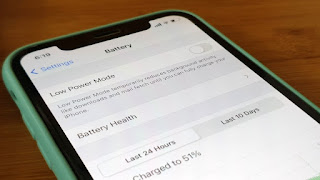How to iPhone battery health

Introduction
The battery on your iPhone is one of the most important components in the device. It provides power to all of its internal components, from the display to the processor to even the camera. If your iPhone’s battery is not performing at its best level, there are several things you can do to optimize its health and get it back up and running as quickly as possible:
iPhone Battery Health
-
The iPhone battery health is a measurement of the condition of your iPhone battery.
-
Health is measured in percentages, with 100% being perfect and 0% being dead. The higher the percentage, the better the health--and vice versa for low numbers.
-
You can check this on iOS 12 or later by going to Settings > Battery > Battery Usage. If you see an icon that says "Low Power Mode" or something similar on there (it might be called "Battery Health"), then your battery is doing well! Otherwise, try turning off Low Power Mode if it's available; sometimes this will improve performance dramatically when you're using apps like WhatsApp or Facebook Messenger at high volume levels for long periods of time because it turns off background data processing so things aren't bogged down by unnecessary processes like syncing photos with iCloud Photo Library or uploading new ones from Photos app where they're stored locally until they need synced back into iCloud backup storage space once again after being shared via AirDrop among friends who have received them through AirDrop sync settings enabled within each respective device user account settings page under General tab heading "General Account Information".
Ideal Battery Health Status
The ideal battery health status of your iPhone is 100%. This means that the battery level should be at 100%, not 0% or 50% or even 80%. If you see these numbers appear on your screen, you need to charge the device immediately.
If this doesn't happen often enough for you (or if it does), then it may be time for a new battery. However, there are some ways that you can help prevent this from happening before too much damage has been done:
Optimize iPhone Battery Charging
To maximize battery life, you should charge your iPhone at a consistent rate and temperature. The right charger and cable are important too.
-
Charge your iPhone in the same way every time you charge it. If you're using an adapter or cable that was not made specifically for your device, make sure it's compatible with iOS 11 and later versions of iOS before using it with your iPhone 6/7 Plus, 7/8 Plus or XS Max devices running on iOS 10 or earlier versions of OS X El Capitan (or macOS Sierra).
-
Use only Apple-certified chargers and cables so that they can keep up with the demands placed upon them by their sophisticated circuitry and software systems.*
How to Turn on Low Power Mode Manually
You can also set a time limit for when you want Low Power Mode to turn on. For example, if your iPhone is running out of juice and you don't want it to be in Low Power Mode all day, simply tap the switch next to the battery icon and select "OFF." This way, even though your phone may still be charging up during this period, it won't drain as much power.
How to Turn on Low Power Mode When Battery is at 20% Power Remaining
-
How to Turn on Low Power Mode When Battery is at 20% Power Remaining
-
How to Check iPhone Battery Health and Optimize iPhone Charging
-
How to Turn on Low Power Mode Manually
How to Turn on Low Power Mode Automatically
You can also turn on Low Power Mode automatically, when your iPhone's battery is at 20%, 15% or 10%.
To do this, go to Settings > Battery > Low Power Mode and select "On" from the menu that appears.
If a battery on an iPhone is in poor health, it should be replaced.
If a battery on an iPhone is in poor health, it should be replaced. The health of a battery can be measured by monitoring its voltage level and capacity to hold a charge. A low-quality battery may cause unexpected shutdowns and other problems with your device, such as unexpected reboots or random restarts.
If you have an iPhone 13, 13 pro or 13 max (which have larger batteries), the battery health is shown in Settings > Battery under "Battery Health."
Conclusion
In this article, we’ve covered some of the most common signs that your iPhone battery is in poor health. If you notice any of these problems, then it may be time to replace your battery. In order to do so, you first need to confirm whether or not Apple recommends replacing your iPhone’s battery (you can check this by going into Settings > Battery). Once you have made sure that Apple does not recommend replacing it on its own and are confident about doing so yourself instead (if applicable), then simply follow the steps below:






